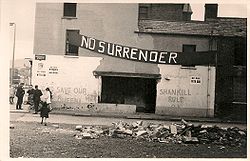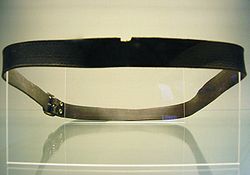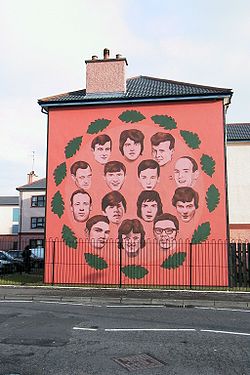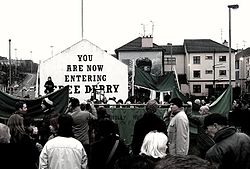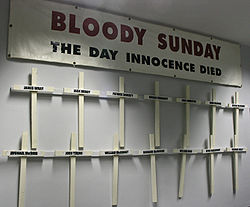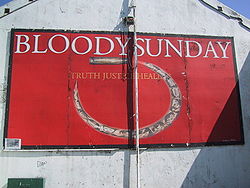- Bloody Sunday (1972)
-
Bloody Sunday (1972) Part of The Troubles 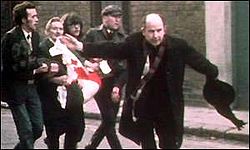
Father Edward Daly waving a blood-stained white handkerchief while trying to escort the mortally wounded Jackie Duddy to safety.Location Derry, Northern Ireland Coordinates 54°59′49″N 7°19′32″W / 54.9969674°N 7.3255581°WCoordinates: 54°59′49″N 7°19′32″W / 54.9969674°N 7.3255581°W Date 30 January 1972
16:10Attack type Shooting Weapon(s) L1A1 SLR rifles Death(s) 13 Injured 13 from gunshots – one of whom died 4½ months later – two from vehicle impact, three from other injuries Perpetrator(s) British Army (Parachute Regiment) Bloody Sunday (Irish: Domhnach na Fola)[1]—sometimes called the Bogside Massacre[2]—was an incident on 30 January 1972 in the Bogside area of Derry, Northern Ireland, in which twenty-six unarmed civil rights protesters and bystanders were shot by soldiers of the British Army. Thirteen males, seven of whom were teenagers, died immediately or soon after, while the death of another man four and a half months later was attributed to the injuries he received on that day. Two protesters were also injured when they were run down by army vehicles.[3] Five of those wounded were shot in the back.[4] The incident occurred during a Northern Ireland Civil Rights Association march; the soldiers involved were the First Battalion of the Parachute Regiment (1 Para).[5]
Two investigations have been held by the British government. The Widgery Tribunal, held in the immediate aftermath of the event, largely cleared the soldiers and British authorities of blame—Widgery described the soldiers' shooting as "bordering on the reckless"—but was criticised as a "whitewash",[6][7][8] including by Jonathan Powell, chief of staff to former prime minister Tony Blair.[9] The Saville Inquiry, chaired by Lord Saville of Newdigate, was established in 1998 to reinvestigate the events. Following a twelve-year inquiry, Saville's report was made public on 15 June 2010, and contained findings of fault that could re-open the controversy, and potentially lead to criminal investigations for some soldiers involved in the killings.[10] The report found that all of those shot were unarmed, and that the killings were both "unjustified and unjustifiable." On the publication of the Saville report the British prime minister, David Cameron, made a formal apology on behalf of the United Kingdom.[11]
The Provisional Irish Republican Army's (IRA) campaign against the partition of Ireland had begun in the two years prior to Bloody Sunday, but public perceptions of the day boosted the status of, and recruitment into, the organisation enormously.[12] Bloody Sunday remains among the most significant events in the Troubles of Northern Ireland, chiefly because it was carried out by the British army and not paramilitaries, in full view of the public and the press.[2]
Contents
Background
In the late 1960s discrimination against the Catholic minority in electoral boundaries, voting rights, and the allocation of public housing[13] led organisations such as Northern Ireland Civil Rights Association (NICRA) to mount a non-violent campaign for change.[14] Following attacks on civil rights marchers by Protestant loyalists, as well as members of the Royal Ulster Constabulary (RUC), anger and violence mounted.[15] In 1969 the Battle of the Bogside broke out in the aftermath of disturbances following an Apprentice Boys of Derry march.[16] The residents of the nationalist Bogside erected barricades around the area to resist police incursions, and, after three days of rioting when the RUC had proved unable to restore order, the government of Northern Ireland requested the deployment of the British Army.[17]
While initially welcomed by the Catholics as a neutral force compared to the RUC, relations between the nationalists and the Army soon deteriorated.[18] On 8 July 1971 two rioters, Seamus Cusack and Desmond Beattie, were shot dead in the Bogside by soldiers in disputed circumstances.[19] Soldiers claimed the pair were armed, which was denied by local people, and moderate nationalists including John Hume and Gerry Fitt walked out of the Parliament of Northern Ireland in protest.[19][20] A British Army memorandum states that as a result of this the situation "changed overnight", with the Provisional IRA's campaign in the city beginning at that time after previously being regarded as "quiescent".[20]
In response to escalating levels of violence across Northern Ireland, internment without trial was introduced on 9 August 1971.[19] In a quid pro quo gesture to nationalists, all marches and parades were banned, including the flashpoint march by the Apprentice Boys of Derry which was due to take place on 12 August.[21] There was disorder across Northern Ireland following the introduction of internment, with 21 people being killed in three days of rioting.[22] On 10 August Bombardier Paul Challenor became the first soldier to be killed by the Provisional IRA in Derry, when he was shot by a sniper on the Creggan estate.[20] A further six soldiers had been killed in Derry by mid-December 1971.[23] 1,932 rounds were fired at the British Army, who also faced 211 explosions and 180 nail bombs[23] and who fired 364 rounds in return.
Provisional IRA activity also increased across Northern Ireland with thirty British soldiers being killed in the remaining months of 1971, in contrast to the ten soldiers killed during the pre-internment period of the year.[22] Both the Official IRA and Provisional IRA had established "no-go" areas for the British Army and RUC in Derry through the use of barricades.[24] By the end of 1971, 29 barricades were in place to prevent access to what was known as Free Derry, 16 of them impassable even to the British Army's one-ton armoured vehicles.[24] IRA members openly mounted roadblocks in front of the media, and daily clashes took place between nationalist youths and the British Army at a spot known as "aggro corner".[24] Due to rioting and damage to shops caused by incendiary devices, an estimated total of £4 million worth of damage had been done to local businesses.[24]
In January 1972 the NICRA intended, despite the ban, to organise a march in Derry to protest against internment. The authorities who knew of the proposed march decided to allow it to proceed in the nationalist areas of the city, but to stop it from reaching Guildhall Square, as planned by the organisers. Major General Robert Ford, then Commander of Land Forces in Northern Ireland, ordered that 1st Battalion, The Parachute Regiment (1 PARA) should travel to Derry to be used to arrest possible rioters during the march.[25] 1 PARA arrived in Derry on the morning of Sunday 30 January 1972 and took up positions in the city.[26]
Events of the day
Many details of the day's events are in dispute, with no agreement even on the number of marchers present that day. The organisers, "Insight", claimed that there were 30,000 marchers; Lord Widgery, in his now discredited tribunal,[27][28][29][30] said that there were only 3,000 to 5,000. In The Road To Bloody Sunday, local GP Dr. Raymond McClean estimated the crowd as 15,000,[31] which is the figure that was used by Bernadette Devlin McAliskey in Parliament.[32]
Numerous books and articles have been written and documentary films have been made on the subject.[33]
Narrative of events
The people planned on marching to the Guildhall, but because of army barricades designed to reroute the march it was redirected to Free Derry Corner. A group of teenagers broke off from the march and persisted in pushing the barricade and marching on the Guildhall. They attacked the British army barricade with stones. At this point, a water cannon, tear gas and rubber bullets were used to disperse the rioters. Such confrontations between soldiers and youths were common, though observers reported that the rioting was not intense.[34] Two civilians, Damien Donaghy and John Johnston were shot and wounded by soldiers on William Street who claimed the former was carrying a black cylindrical object.[35]
At a certain point, reports of an IRA sniper operating in the area were allegedly given to the Army command centre. At 4:07 pm Brigade gave the British Parachute Regiment permission to go in to the Bogside. The order to fire live rounds was given, and one young man was shot and killed when he ran down Chamberlain Street away from the advancing troops. This first fatality, Jackie Duddy, was among a crowd who were running away. He was running alongside a priest, Father Edward Daly, when he was shot in the back. Continuing violence by British troops escalated, and eventually the order was given to mobilise the troops in an arrest operation, chasing the tail of the main group of marchers to the edge of the field by Free Derry Corner.
Despite a cease-fire order from the army HQ, over a hundred rounds were fired directly into the fleeing crowds by troops under the command of Major Ted Loden. Twelve more were killed,[36] many of them as they attempted to aid the fallen. Fourteen others were wounded, twelve by shots from the soldiers and two knocked down by armoured personnel carriers.
The dead
- John (Jackie) Duddy (17). Shot in the chest in the car park of Rossville flats. Four witnesses stated Duddy was unarmed and running away from the paratroopers when he was killed. Three of them saw a soldier take deliberate aim at the youth as he ran. He is the uncle of the Irish boxer John Duddy.[37]
- Patrick Joseph Doherty (31). Shot from behind while attempting to crawl to safety in the forecourt of Rossville flats. Doherty was the subject of a series of photographs, taken before and after he died by French journalist Gilles Peress. Despite testimony from "Soldier F" that he had fired at a man holding and firing a pistol, Widgery acknowledged that the photographs showed Doherty was unarmed, and that forensic tests on his hands for gunshot residue proved negative.[37][39]
- Bernard McGuigan (41). Shot in the back of the head when he went to help Patrick Doherty. He had been waving a white handkerchief at the soldiers to indicate his peaceful intentions.[5]
- Hugh Pious Gilmour (17). Shot through his right elbow, the bullet then entering his chest as he ran from the paratroopers on Rossville Street.[37] Widgery acknowledged that a photograph taken seconds after Gilmour was hit corroborated witness reports that he was unarmed, and that tests for gunshot residue were negative.[5]
- Kevin McElhinney (17). Shot from behind while attempting to crawl to safety at the front entrance of the Rossville Flats. Two witnesses stated McElhinney was unarmed.[37]
- Michael Gerald Kelly (17). Shot in the stomach while standing near the rubble barricade in front of Rossville Flats. Widgery accepted that Kelly was unarmed.[37]
- John Pius Young (17). Shot in the head while standing at the rubble barricade. Two witnesses stated Young was unarmed.[37]
- William Noel Nash (19). Shot in the chest near the barricade. Witnesses stated Nash was unarmed and going to the aid of another when killed.[37]
- Michael M. McDaid (20). Shot in the face at the barricade as he was walking away from the paratroopers. The trajectory of the bullet indicated he could have been killed by soldiers positioned on the Derry Walls.[37]
- James Joseph Wray (22). Wounded then shot again at close range while lying on the ground. Witnesses who were not called to the Widgery Tribunal stated that Wray was calling out that he could not move his legs before he was shot the second time.[37]
- Gerald Donaghy (17). Shot in the stomach while attempting to run to safety between Glenfada Park and Abbey Park. Donaghy was brought to a nearby house by bystanders where he was examined by a doctor. His pockets were turned out in an effort to identify him. A later police photograph of Donaghy's corpse showed nail bombs in his pockets. Neither those who searched his pockets in the house nor the British army medical officer (Soldier 138) who pronounced him dead shortly afterwards say they saw any bombs. Donaghy had been a member of Fianna Éireann, an IRA-linked Republican youth movement.[37] Paddy Ward, a police informer[40] who gave evidence at the Saville Inquiry, claimed that he had given two nail bombs to Donaghy several hours before he was shot dead.[41]
- Gerald (James) McKinney (34). Shot just after Gerald Donaghy. Witnesses stated that McKinney had been running behind Donaghy, and he stopped and held up his arms, shouting "Don't shoot! Don't shoot!", when he saw Donaghy fall. He was then shot in the chest.[37]
- William Anthony McKinney (27). Shot from behind as he attempted to aid Gerald McKinney (no relation). He had left cover to try to help Gerald.[37]
- John Johnston (59). Shot in the leg and left shoulder on William Street 15 minutes before the rest of the shooting started.[37][42] Johnston was not on the march, but on his way to visit a friend in Glenfada Park.[42] He died 4½ months later; his death has been attributed to the injuries he received on the day. He was the only one not to die immediately or soon after being shot.[37]
Perspectives and analyses on the day
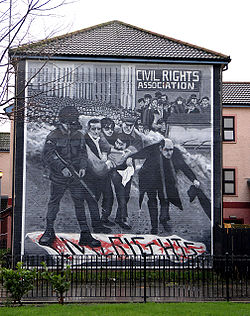 Mural by Bogside Artists on Free Derry Corner depicting Father Daly waving a white handkerchief while trying to escort the mortally wounded Jackie Duddy to safety.
Mural by Bogside Artists on Free Derry Corner depicting Father Daly waving a white handkerchief while trying to escort the mortally wounded Jackie Duddy to safety.
Thirteen people were shot and killed, with another man later dying of his wounds. The official army position, backed by the British Home Secretary the next day in the House of Commons, was that the paratroopers had reacted to gun and nail bomb attacks from suspected IRA members. All eyewitnesses (apart from the soldiers), including marchers, local residents, and British and Irish journalists present, maintain that soldiers fired into an unarmed crowd, or were aiming at fleeing people and those tending the wounded, whereas the soldiers themselves were not fired upon. No British soldier was wounded by gunfire or reported any injuries, nor were any bullets or nail bombs recovered to back up their claims.
In the events that followed, irate crowds burned down the British embassy on Merrion Square in Dublin.[43] Anglo-Irish relations hit one of their lowest ebbs, with Irish Minister for Foreign Affairs, Patrick Hillery, going specially to the United Nations in New York to demand UN involvement in the Northern Ireland "Troubles".[44]
Although there were many IRA men—both Official and Provisional—present at the protest, it is claimed they were all unarmed, apparently because it was anticipated that the paratroopers would attempt to "draw them out".[45] March organizer and MP Ivan Cooper had been promised beforehand that no armed IRA men would be near the march. One paratrooper who gave evidence at the Tribunal testified that they were told by an officer to expect a gunfight and "We want some kills".[46] In the event, one man was witnessed by Father Edward Daly and others haphazardly firing a revolver in the direction of the paratroopers. Later identified as a member of the Official IRA, this man was also photographed in the act of drawing his weapon, but was apparently not seen or targeted by the soldiers. Various other claims have been made to the Saville Inquiry about gunmen on the day.[47]
The city's coroner, retired British Army Major Hubert O'Neill, issued a statement on 21 August 1973, at the completion of the inquest into the people killed.[48] He declared:
This Sunday became known as Bloody Sunday and bloody it was. It was quite unnecessary. It strikes me that the Army ran amok that day and shot without thinking what they were doing. They were shooting innocent people. These people may have been taking part in a march that was banned but that does not justify the troops coming in and firing live rounds indiscriminately. I would say without hesitation that it was sheer, unadulterated murder. It was murder.Two days after Bloody Sunday, the Westminster Parliament adopted a resolution for a tribunal into the events of the day, resulting in Prime Minister Edward Heath commissioning the Lord Chief Justice, Lord Widgery to undertake it. Many witnesses intended to boycott the tribunal as they lacked faith in Widgery's impartiality, but were eventually persuaded to take part. Widgery's quickly produced report—completed within ten weeks (10 April) and published within eleven (19 April)—supported the Army's account of the events of the day. Among the evidence presented to the tribunal were the results of paraffin tests, used to identify lead residues from firing weapons, and that nail bombs had been found on the body of one of those killed. Tests for traces of explosives on the clothes of eleven of the dead proved negative, while those of the remaining man could not be tested as they had already been washed. Most Irish people and witnesses to the event disputed the report's conclusions and regarded it as a whitewash. It has been argued that firearms residue on some deceased may have come from contact with the soldiers who themselves moved some of the bodies, or that the presence of lead on the hands of one (James Wray) was easily explained by the fact that his occupation involved the use of lead-based solder. In fact, in 1992, John Major, writing to John Hume stated:
The Government made clear in 1974 that those who were killed on 'Bloody Sunday' should be regarded as innocent of any allegation that they were shot whilst handling firearms or explosives. I hope that the families of those who died will accept that assurance.[49]Following the events of Bloody Sunday Bernadette Devlin, an Independent Socialist nationalist MP from Northern Ireland, expressed anger at what she perceived as government attempts to stifle accounts being reported about the day. Having witnessed the events firsthand, she was later infuriated that she was consistently denied the chance to speak in Parliament about the day, although parliamentary convention decreed that any MP witnessing an incident under discussion would be granted an opportunity to speak about it in the House.[50] Devlin punched Reginald Maudling, the Secretary of State for the Home Department in the Conservative government, when he made a statement to Parliament on the events of Bloody Sunday stating that the British Army had fired only in self-defence.[51] She was temporarily suspended from Parliament as a result of the incident.[52]
In January 1997, the United Kingdom television station Channel 4 carried a news report that suggested that members of the Royal Anglian Regiment had also opened fire on the protesters and could have been responsible for three of the fourteen deaths.
On 29 May 2007 it was reported that General Sir Mike Jackson, second-in-command of 1 Para on Bloody Sunday, said: "I have no doubt that innocent people were shot".[53] This was in sharp contrast to his insistence, for more than 30 years, that those killed on the day had not been innocent.[54]
The Saville Inquiry
Although British Prime Minister John Major rejected John Hume's requests for a public inquiry into the killings, his successor, Tony Blair, decided to start one. A second commission of inquiry, chaired by Lord Saville, was established in January 1998 to re-examine 'Bloody Sunday'. The other judges were John Toohey QC, a former Justice of the High Court of Australia who had worked on Aboriginal issues (he replaced New Zealander Sir Edward Somers QC, who retired from the Inquiry in 2000 for personal reasons), and Mr Justice William Hoyt QC, former Chief Justice of New Brunswick and a member of the Canadian Judicial Council. The hearings were concluded in November 2004, and the report was published 15 June 2010. The Saville Inquiry was a more comprehensive study than the Widgery Tribunal, interviewing a wide range of witnesses, including local residents, soldiers, journalists and politicians. Lord Saville declined to comment on the Widgery report and made the point that the Saville Inquiry was a judicial inquiry into 'Bloody Sunday', not the Widgery Tribunal.
Evidence given by Martin McGuiness, a senior member of Sinn Féin and now the deputy First Minister of Northern Ireland, to the inquiry stated that he was second-in-command of the Derry City brigade of the Provisional IRA and was present at the march. He did not answer questions about where he had been staying because he said it would compromise the safety of the individuals involved.
A claim was made at the Saville Inquiry that McGuinness was responsible for supplying detonators for nail bombs on Bloody Sunday. Paddy Ward claimed he was the leader of the Fianna Éireann, the youth wing of the IRA in January 1972. He claimed McGuinness, the second-in-command of the IRA in the city at the time, and another anonymous IRA member gave him bomb parts on the morning of 30 January, the date planned for the civil rights march. He said his organisation intended to attack city-centre premises in Derry on the day when civilians were shot dead by British soldiers. In response McGuinness rejected the claims as "fantasy", while Gerry O'Hara, a Sinn Féin councillor in Derry stated that he and not Ward was the Fianna leader at the time.[41]
Many observers allege that the Ministry of Defence acted in a way to impede the inquiry.[55] Over 1,000 army photographs and original army helicopter video footage were never made available. Additionally, guns used on the day by the soldiers that could have been evidence in the inquiry were lost by the MoD.[56][57] The MoD claimed that all the guns had been destroyed, but some were subsequently recovered in various locations (such as Sierra Leone and Beirut) despite the obstruction.[58]
By the time the inquiry had retired to write up its findings, it had interviewed over 900 witnesses, over seven years, making it the biggest investigation in British legal history.[57] The cost of this process has drawn criticism; as of the publication of the Saville Report being £195 million.[59]
The inquiry was expected to report in late 2009 but was delayed until after the general election on 6 May 2010.[60]
The report of the inquiry[61] was published on 15 June 2010. The report concluded, "The firing by soldiers of 1 PARA on Bloody Sunday caused the deaths of 13 people and injury to a similar number, none of whom was posing a threat of causing death or serious injury."[62] Saville stated that British paratroopers "lost control", fatally shooting fleeing civilians and those who tried to aid the civilians who had been shot by the British soldiers.[63] The report stated that British soldiers had concocted lies in their attempt to hide their acts.[63] Saville stated that the civilians had not been warned by the British soldiers that they intended to shoot.[64] The report states, contrary to the previously established belief, that no stones and no petrol bombs were thrown by civilians before British soldiers shot at them, and that the civilians were not posing any threat.[63]
The report concluded that an Official IRA sniper fired on British soldiers, albeit on the balance of evidence his shot was fired after the Army shots that wounded Damien Donaghey and John Johnston. The Inquiry rejected the sniper's account that this shot had been made in reprisal, stating the view that he and another Official IRA member had already been in position, and the shot had probably been fired simply because the opportunity had presented itself.[65] Ultimately, the Saville Inquiry was inconclusive on Martin McGuiness' role due to a lack of certainty over his movements, concluding that while he was "engaged in paramilitary activity" during Bloody Sunday, and had probably been armed with a Thompson submachine gun, there was insufficient evidence to make any finding other than they were "sure that he did not engage in any activity that provided any of the soldiers with any justification for opening fire".[66]
Impact on Northern Ireland divisions
Harold Wilson, then the Leader of the Opposition in the Commons, reiterated his belief that a united Ireland was the only possible solution to Northern Ireland's Troubles. William Craig, then Stormont Home Affairs Minister, suggested that the west bank of Derry should be ceded to the Republic of Ireland.
When it was deployed on duty in Northern Ireland, the British Army was welcomed by Roman Catholics as a neutral force there to protect them from Protestant mobs, the Royal Ulster Constabulary (RUC) and the B-Specials.[67] After Bloody Sunday many Catholics turned on the British army, seeing it no longer as their protector but as their enemy. Young nationalists became increasingly attracted to violent republican groups. With the Official IRA and Official Sinn Féin having moved away from mainstream Irish republicanism towards Marxism, the Provisional IRA began to win the support of newly radicalised, disaffected young people.
In the following twenty years, the Provisional Irish Republican Army and other smaller republican groups such as the Irish National Liberation Army (INLA) mounted an armed campaign against the British, by which they meant the RUC, the British Army, the Ulster Defence Regiment (UDR) of the British Army (and, according to their critics, the Protestant and unionist establishment). With rival paramilitary organisations appearing in both the nationalist/republican and Irish unionist/Ulster loyalist communities (the Ulster Defence Association, Ulster Volunteer Force (UVF), etc. on the loyalist side), the Troubles cost the lives of thousands of people. Incidents included the killing of three members of a pop band, the Miami Showband, by a gang including members of the UVF who were also members of the local army regiment, the UDR, and in uniform at the time,[68] and the killing by the Provisionals of eighteen members of the Parachute Regiment in the Warrenpoint Ambush-seen by some as revenge for Bloody Sunday.
With the official cessation of violence by some of the major paramilitary organisations and the creation of the power-sharing executive at Stormont in Belfast under the 1998 Good Friday Agreement, the Saville Inquiry's re-examination of the events of that day is widely hoped to provide a thorough account of the events of Bloody Sunday.
In his speech to the House of Commons on the Inquiry, British Prime Minister David Cameron stated: "These are shocking conclusions to read and shocking words to have to say. But you do not defend the British Army by defending the indefensible."[69] He acknowledged that all those who died were unarmed when they were killed by British soldiers and that a British soldier had fired the first shot at civilians. He also said that this was not a premeditated action, though "there was no point in trying to soften or equivocate" as "what happened should never, ever have happened". Cameron then apologised on behalf of the British Government by saying he was "deeply sorry".
A survey conducted by Angus Reid Public Opinion in June 2010 found that 61 per cent of Britons and 70 per cent of Northern Irish agreed with Cameron’s apology for the Bloody Sunday events.[70]
Stephen Pollard, solicitor representing several of the soldiers, said on 15 June 2010 that Saville had cherry-picked the evidence and did not have justification for his findings.[71]
Artistic reaction
The incident has been commemorated by Irish band, U2, in their 1983 protest song "Sunday Bloody Sunday".[72]
The John Lennon album Some Time in New York City features a song entitled "Sunday Bloody Sunday", inspired by the incident, as well as the song "The Luck of the Irish", which dealt more with the Irish conflict in general. Lennon, who was of Irish descent, also spoke at a protest in New York in support of the victims and families of Bloody Sunday.[73]
The Roy Harper song "All Ireland" from the album 'Lifemask', written in the days following the incident, is critical of the military but takes a long term view with regard to a solution. In Harper's book ('The Passions Of Great Fortune'), his comment on the song ends '..there must always be some hope that the children of 'Bloody Sunday', on both sides, can grow into some wisdom'.
Paul McCartney (also of Irish descent[74]) issued a single shortly after Bloody Sunday titled "Give Ireland Back to the Irish", expressing his views on the matter. It was one of few McCartney solo songs to be banned by the BBC.[75]
Black Sabbath's Geezer Butler (also of Irish descent) wrote the lyrics to the Black Sabbath song "Sabbath Bloody Sabbath" on the album of the same name in 1973. Butler stated, "… the Sunday Bloody Sunday thing had just happened in Ireland, when the British troops opened fire on the Irish demonstrators... So I came up with the title ‘Sabbath Bloody Sabbath,’ and sort of put it in how the band was feeling at the time, getting away from management, mixed with the state Ireland was in."[76]
Christy Moore's song "Minds Locked Shut" on the album "Graffiti Tongue" is all about the events of the day, and names the dead civilians.[77]
The Celtic metal band Cruachan addressed the incident in a song "Bloody Sunday" from their 2004 album Folk-Lore.[78]
The events of the day have been dramatised in the two 2002 television dramas, Bloody Sunday (starring James Nesbitt) and Sunday by Jimmy McGovern.[72]
Brian Friel's 1973 play The Freedom of the City deals with the incident from the viewpoint of three civilians.[72]
Irish poet Thomas Kinsella's 1972 poem Butcher's Dozen is a satirical and angry response to the Widgery Tribunal and the events of Bloody Sunday.
Willie Doherty, a Derry-born artist has amassed a large body of work which addresses the troubles in Northern Ireland. "30 January 1972" deals specifically with the events of Bloody Sunday.[72]
In mid-2005, the play Bloody Sunday: Scenes from the Saville Inquiry, a dramatisation based on the Saville Inquiry, opened in London, and subsequently travelled to Derry and Dublin.[79][80] The writer, journalist Richard Norton-Taylor, distilled four years of evidence into two hours of stage performance by Tricycle Theatre. The play received glowing reviews in all the British broadsheets, including The Times: "The Tricycle's latest recreation of a major inquiry is its most devastating"; The Daily Telegraph: "I can't praise this enthralling production too highly ... exceptionally gripping courtroom drama"; and The Independent: "A necessary triumph".[81]
The Wolfe Tones, an Irish rebel music band, wrote a song also called "Sunday Bloody Sunday" about the event.[82]
Swedish troubadour Fred Åkerström wrote a song called "Den 30/1-72" about the incident.
In October 2010, T with the Maggies released the song Domhnach na Fola (Irish for Bloody Sunday), written by Mairéad Ní Mhaonaigh and Tríona Ní Dhomhnaill on their debut album.
References in popular music
Shots were fired by a mindless military,
The people ran they were unarmed
Across the world we will read of Derry
And those who died by oppressive hands.Well it was Sunday bloody Sunday
When they shot the people there
The cries of thirteen martyrs
Filled the Free Derry air
Is there any one amongst you
Dare to blame it on the kids?
Not a soldier boy was bleeding
When they nailed the coffin lids!And the battle's just begun
There's many lost, but tell me who has won?
The trenches dug within our hearts
And mothers, children, brothers, sisters
Torn apart!
Sunday, bloody Sunday.
Sunday, bloody Sunday.References
- ^ "CAIN: Posters – Examples of Bloody Sunday Posters". Cain.ulst.ac.uk. 30 January 1972. http://cain.ulst.ac.uk/images/posters/bsunday/index.html. Retrieved 17 June 2010.
- ^ a b Eamonn McCann (2006). The Bloody Sunday Inquiry – The Families Speak Out. London: Pluto Press. ISBN 0-7453-2510-6. pp. 4–6
- ^ 'Bloody Sunday', Derry 30 January 1972 – Names of the Dead and Injured CAIN Web Service, 23 March 2006. Retrieved 27 August 2006.
- ^ Extracts from 'The Road to Bloody Sunday' by Dr. Raymond McClean. Retrieved 16 February 2007.
- ^ a b c "Widgery Report". CAIN. http://cain.ulst.ac.uk/hmso/widgery.htm. Retrieved 18 May 2007.
- ^ David Granville (28 July 2005). "More 'butcher' than 'grocer'". The Morning Star. http://www.irishdemocrat.co.uk/features/more-butcher-than-grocer/. Retrieved 18 May 2007.
- ^ Nick Cohen (1 February 2004). "Schooled in scandal". London: The Guardian. http://politics.guardian.co.uk/kelly/comment/0,,1136486,00.html. Retrieved 18 May 2007.
- ^ "1972: 'Bloody Sunday' report excuses Army". BBC News. 19 April 1972. http://news.bbc.co.uk/onthisday/hi/dates/stories/april/19/newsid_2491000/2491125.stm. Retrieved 18 May 2007.
- ^ Nicholas Watt (19 March 2008). McGuinness: there was no need for Bloody Sunday inquiry. The Guardian
- ^ McDonald, Henry; Norton-Taylor, Richard (10 June 2010). "Bloody Sunday killings to be ruled unlawful". London: The Guardian. http://www.guardian.co.uk/uk/2010/jun/10/bloody-sunday-inquiry-northern-ireland. Retrieved 12 June 2010.
- ^ . BBC. 15 June 2010. http://www.bbc.co.uk/news/10320609 Bloody Sunday report published. Retrieved 8 April 2011.
- ^ Peter Pringle and Philip Jacobson (2000). Those Are Real Bullets, Aren't They?. London: Fourth Estate. ISBN 1-84115-316-8. P. 293: "Youngsters who had seen their friends die that day flocked to join the IRA ..."
- ^ Gallager et al (1983). Contemporary Irish Studies. Manchester University Press. ISBN 0 7190 0919 7. http://cain.ulst.ac.uk/issues/discrimination/whyte.htm#chap1. Retrieved 21 April 2011.
- ^ Bob Purdie (1990). Politics in the Streets: The origins of the civil rights movement in Northern Ireland. Blackstaff Press. ISBN 0 85640 437 3. http://cain.ulst.ac.uk/events/crights/purdie.htm#nicra. Retrieved 21 April 2011.
- ^ Eamonn McCann (1993). War and an Irish Town. Pluto Press. ISBN 1 7453 0725 6. http://cain.ulst.ac.uk/events/crights/mccann93.htm. Retrieved 21 Apr 2011.
- ^ BBC News (12 August 1969). "Police use tear gas in Bogside". http://news.bbc.co.uk/onthisday/hi/dates/stories/august/12/newsid_3829000/3829219.stm. Retrieved 21 April 2011.
- ^ Russell Stetler (1970). The Battle of Bogside: The Politics of Violence in Northern Ireland. Sheed and Ward. ISBN 7220 0614 4. http://cain.ulst.ac.uk/events/battlebogside/stetler/stetler70.htm#august. Retrieved 21 Apr 2011.
- ^ Niall O Dochartaigh (1997). FROM CIVIL RIGHTS TO ARMALITES: Derry and the Birth of the Irish Troubles. Cork University Press. ISBN 20111 85918 108. http://cain.ulst.ac.uk/events/troops/chap4.htm#honey. Retrieved 19 April 2011.
- ^ a b c Geraghty, Tony (2000). The Irish War: The Hidden Conflict Between the IRA and British Intelligence. Harper Collins. p. 45. ISBN 978-0006386742.
- ^ a b c Taylor, Peter (2001). Brits: The War Against the IRA. Bloomsbury Publishing. p. 83. ISBN 0-7475-5806-X.
- ^ The Irish War: The Hidden Conflict Between the IRA and British Intelligence, p. 46.
- ^ a b English, Richard (2003). Armed Struggle: The History of the IRA. Pan Books. p. 141. ISBN 0-330-49388-4.
- ^ a b Brits, p. 84.
- ^ a b c d Brits, p. 82.
- ^ Bloody Sunday Inquiry (2010). Report of The Bloody Sunday Inquiry. 2.15-2.16. http://report.bloody-sunday-inquiry.org/volume01/chapter002. Retrieved 22 Apr 2011.
- ^ Bloody Sunday Inquiry (2010). Report of The Bloody Sunday Inquiry. 3.1. http://report.bloody-sunday-inquiry.org/volume01/chapter003. Retrieved 22 Apr 2011.
- ^ "'Relief and vindication in Derry at findings in 5,000-page report'". The Irish Times. http://www.irishtimes.com/newspaper/ireland/2010/0616/1224272613911.html. Retrieved Saturday, 26 March 2011.
- ^ Bingham, John; Prince, Rosa; Harding, Thomas (14 June 2010). "'Bloody Sunday: soldiers should face trial but not jail, families say'". London: The Telegraph. http://www.telegraph.co.uk/news/uknews/northernireland/7827351/Bloody-Sunday-soldiers-should-face-trial-but-not-jail-families-say.html. Retrieved Saturday 26 March 2011.
- ^ "'saville widgery'". London: The Independent. http://search.independent.co.uk/topic/saville-widgery. Retrieved Saturday, 26 March 2011.
- ^ "'Written Answers. – Bloody Sunday Inquiry'". House of the Oireachtas. http://debates.oireachtas.ie/dail/1997/02/06/00031.asp. Retrieved Saturday, 26 March 2011.
- ^ McClean, Raymond (1983). "Extracts from The Road to Bloody Sunday". Conflict Archive on the Internet. Derry: Guildhall Press. http://cain.ulst.ac.uk/events/bsunday/mcclean.htm. Retrieved 16 June 2010.
- ^ Parliamentary Debates, House of Commons, 1 February 1972, columns 264–331.
- ^ "'Bloody Sunday', Derry 30 January 1972 – Details of Source Material". CAIN Web Service. http://cain.ulst.ac.uk/events/bsunday/soc.htm. Retrieved 16 June 2010.
- ^ Peter Pringle & Philip Jacobson (2000). Those Are Real Bullets, Aren't They?. London: Fourth Estate. ISBN 1-84115-316-8. P. 100: "... the level of rioting was no greater than usual – and no petrol bombs or nail bombs were being thrown."
- ^ Peter Pringle and Philip Jacobson (2000). Those Are Real Bullets, Aren't They?. London: Fourth Estate. ISBN 1-84115-316-8.P 116: "Seconds after the corporal fired, he would say that he spotted the same man with a black cylindrical object in one hand strike what appeared to be a match against the wall. Johnston was standing a few feet from Donaghy. One of the bullets sliced through his right thigh."
- ^ "CAIN: Events: Bloody Sunday: Menu Page". Cain.ulst.ac.uk. http://cain.ulst.ac.uk/events/bsunday/bs.htm. Retrieved 17 June 2010.
- ^ a b c d e f g h i j k l m n "'Bloody Sunday', Derry 30 January 1972". CAIN. http://cain.ulst.ac.uk/events/bsunday/circum.htm. Retrieved 16 May 2007.
- ^ "Superb new look for Museum of Free Derrya". Derryjournal.com. http://www.derryjournal.com/journal/Superb-new-look-for-Museum.4816245.jp?articlepage=2. Retrieved 17 June 2010.
- ^ "Inquiry urged to identify soldiers". BBC News. 23 May 2002. http://news.bbc.co.uk/1/hi/northern_ireland/2004398.stm. Retrieved 16 May 2007.
- ^ http://www.derryjournal.com/journal/Death-of-39informer39-.6096320.jp
- ^ a b John Innes (21 October 2003). "McGuinness is named as bomb runner". Edinburgh: The Scotsman. http://news.scotsman.com/topics.cfm?tid=628&id=1161662003. Retrieved 18 May 2007.
- ^ a b Brits, p. 96.
- ^ 1972: British embassy in Dublin destroyed BBC News Online. Retrieved 1 February 2009.
- ^ Coogan, Tim Pat (2002). The troubles: Ireland's ordeal, 1966–1996, and the search for peace. Palgrave Macmillan. p. 107. ISBN 1570981442 978-1570981449. http://books.google.com/?id=33sWKhmPl3UC&pg=PA107. Retrieved 16 June 2010.
- ^ David Sharrock (30 March 2000). "Rumours of plan to clear Bogside are 'nonsense'". London: The Daily Telegraph. Archived from the original on 27 June 2002. http://web.archive.org/web/20020627205642/http://www.telegraph.co.uk/htmlContent.jhtml?html=/archive/2000/03/30/nuls130.html. Retrieved 16 June 2010.
- ^ The Irish War: The Hidden Conflict Between the IRA and British Intelligence, p. 65.
- ^ "Bloody Sunday Inquiry Transcript – Day 008". 6 April 2000. Archived from the original on 28 September 2007. http://web.archive.org/web/20070928040549/http://www.bloody-sunday-inquiry.org.uk/transcripts/Archive/Ts008.htm. Retrieved 17 May 2007.
- ^ 'Bloody Sunday', 30 January 1972 – A Chronology of Events CAIN Web Service, 23 March 2006. Retrieved 27 August 2006.
- ^ Don Mullan (1997). Eyewitness Bloody Sunday. Wolfhound: Printing Press. ISBN 0-86327-586-9.
- ^ Ros Wynne-Jones (9 March 1997). "Daughters of Ireland". The Independent. http://findarticles.com/p/articles/mi_qn4158/is_19970309/ai_n14092582/pg_2. Retrieved 2 June 2007.[dead link]
- ^ "1969: Devlin is youngest-ever woman MP". BBC. 17 April 1969. http://news.bbc.co.uk/onthisday/hi/dates/stories/april/17/newsid_2524000/2524881.stm. Retrieved 2 June 2007.
- ^ David McKittrick (26 January 1997). "Bloody Sunday: the ghosts that won't lie down". The Independent. http://findarticles.com/p/articles/mi_qn4158/is_19970126/ai_n9645930. Retrieved 2 June 2007.[dead link]
- ^ "Bloody Sunday victims 'innocent'". BBC News Online. 29 May 2007. http://news.bbc.co.uk/1/hi/northern_ireland/6699729.stm. Retrieved 29 May 2007.
- ^ "Bloody Sunday victims innocent says Jackson", Irish News (Belfast newspaper), 29 May 2007, pp. 1 and 11.
- ^ "Bloody Sunday footage release calls". BBC News. 30 January 2003. http://news.bbc.co.uk/1/hi/northern_ireland/2710309.stm. Retrieved 18 May 2007.
- ^ "Concern over Bloody Sunday guns". BBC News. 3 April 2000. http://news.bbc.co.uk/1/hi/northern_ireland/699875.stm. Retrieved 18 May 2007.
- ^ a b Brown, Derek (22 November 2004). "Q&A: Bloody Sunday inquiry". London: The Guardian. http://www.guardian.co.uk/bloodysunday/article/0,2763,1357102,00.html. Retrieved 18 May 2007.
- ^ Philip Jacobson (14 August 2005). "Riddle of the Derry guns". London: The Sunday Times. http://www.timesonline.co.uk/tol/life_and_style/article551570.ece. Retrieved 18 May 2007.
- ^ "Bloody Sunday Report Published.". BBC News. 15 June 2010. http://news.bbc.co.uk/1/hi/northern_ireland/10320609.stm. Retrieved 15 June 2010.
- ^ "Saville Bloody Sunday inquiry delayed until after poll". BBC News. 6 April 2010. http://news.bbc.co.uk/1/hi/northern_ireland/foyle_and_west/8606048.stm. Retrieved 6 April 2010.
- ^ "Report of the The Bloody Sunday Inquiry". 15 June 2010. http://report.bloody-sunday-inquiry.org/. Retrieved 15 June 2010.
- ^ "The overall assessment". Report of the The Bloody Sunday Inquiry. 15 June 2010. http://report.bloody-sunday-inquiry.org/volume01/chapter005/. Retrieved 15 June 2010.
- ^ a b c John Bingham, Rosa Prince and Thomas Harding (15 June 2010). "Bloody Sunday Inquiry: victims were all unarmed and killed without justification, says Saville report". The Daily Telegraph (London: Telegraph Media Group). http://www.telegraph.co.uk/news/uknews/northernireland/7829208/Bloody-Sunday-Inquiry-victims-were-all-unarmed-and-killed-without-justification-says-Saville-report.html. Retrieved 15 June 2010.
- ^ "Bloody Sunday report states those killed were innocent". BBC News (BBC). 15 June 2010. http://news.bbc.co.uk/2/hi/northern_ireland/10320609.stm. Retrieved 15 June 2010.
- ^ "Report of the The Bloody Sunday Inquiry – Volume I – Chapter 3". Bloody Sunday Inquiry. 15 June 2010. http://report.bloody-sunday-inquiry.org/volume01/chapter003/#the-report. Retrieved 15 June 2010.
- ^ "Report of the The Bloody Sunday Inquiry – Volume I – Chapter 3". Bloody Sunday Inquiry. 15 June 2010. http://report.bloody-sunday-inquiry.org/volume01/chapter003/#the-report. Retrieved 15 June 2010. "3.119 In the course of investigating the activities of the Provisional and Official IRA on the day, we considered at some length allegations that Martin McGuinness, at that time the Adjutant of the Derry Brigade or Command of the Provisional IRA, had engaged in paramilitary activity during the day. In the end we were left in some doubt as to his movements on the day. Before the soldiers of Support Company went into the Bogside he was probably armed with a Thompson sub-machine gun, and though it is possible that he fired this weapon, there is insufficient evidence to make any finding on this, save that we are sure that he did not engage in any activity that provided any of the soldiers with any justification for opening fire."
- ^ This "Honeymoon period", as it has come to be known, ended around the time of the Falls Road Curfew on 3 July 1970. See CAIN for details here [1]. The 'B-Specials' were disbanded and replaced by the Ulster Defence Regiment (UDR) on 1 April 1970.
- ^ 1976: UDR men jailed for Showband killings.
- ^ RTÉ News (15 June 2010). "Bloody Sunday killings 'unjustifiable'". http://www.rte.ie/news/2010/0615/bloodysunday.html.
- ^ Angus Reid Public Opinion (28 June 2010). "Britons and Northern Irish Welcome PM’s Apology for Bloody Sunday". Angus Reid Public Opinion. http://www.visioncritical.com/wp-content/uploads/2010/06/2010.06.28_Sunday_BRI.pdf. Retrieved 28 June 2010.
- ^ Mark Devenport, BBC NI Political Editor (30 January 1972). "Bloody Sunday killings 'unjustified and unjustifiable'". BBC News. http://news.bbc.co.uk/2/hi/northern_ireland/10320609.stm. Retrieved 17 June 2010.
- ^ a b c d Bloody Sunday in popular culture 15 June 2010. www.telegraph.co.uk. Retrieved 2010 June 20.
- ^ Irish Genealogy John Lennon at New York protest.
- ^ Experience Festival McCartney bio
- ^ The seven ages of Paul McCartney BBC News Entertainment, 17 June 2006. Retrieved 27 August 2006.
- ^ Black Sabbath: Doom Let Loose, Martin Popoff; ECW Press, 2006.
- ^ Minds Locked Shut www.christymoore.com. Retrieved 2010 June 20.
- ^ Bolther, Giancarlo. "Interview with Keith Fay". Rock-impressions.com. http://rock-impressions.com/cruachan_inter1e.htm. Retrieved 24 March 2008.
- ^ Liz Hoggard (27 March 2005). "Out of crises, a drama". The Guardian (London). http://www.guardian.co.uk/arts/features/story/0,11710,1446221,00.html. Retrieved 19 February 2009.
- ^ "Bloody Sunday: Scenes from the Saville Inquiry". Dublinks. 2005. http://www.dublinks.com/index.cfm/loc/14/pt/0/spid/85F418D2-6CD9-4669-8A9FA731AF2AB0CC.htm. Retrieved 19 February 2009.
- ^ "Bloody Sunday: Scenes from the Saville Inquiry". Tricycle Theatre. 2005. Archived from the original on 5 April 2005. http://web.archive.org/web/20050405182630/http://www.tricycle.co.uk/htmlnew/whatson/show.php3?id=71. Retrieved 19 February 2009.
- ^ Sunday Bloody Sunday Lyrics Retrieved 2010 June 20.
Further reading
- Tony Geraghty (2000). The Irish War. Johns Hopkins University Press. ISBN 0-8018-7117-4.
- Dr Raymond McClean (1997). The Road To Bloody Sunday (revised edition). Guildhall: Printing Press. ISBN 0-946451-37-0. (extracts available online)
- Eamonn McCann (1998). Bloody Sunday In Derry. Brandon: Printing Press. ISBN 0-86322-139-4.
- Dermot P.J. Walsh (2000). Bloody Sunday and the rule of law in Northern Ireland. Gill & Macmillan. ISBN 0-7171-3085-1.
- Jennifer Faus (2007). Before Sunday. Nonsuch Publishing. ISBN 1845885732.
External links
- The Bloody Sunday Trust
- Madden & Finucane Bloody Sunday index
- CAIN Web Service Bloody Sunday index
- UTV Coverage: Bloody Sunday & The Saville Report
- Guardian Coverage
- Dáil debate on Bloody Sunday
- The Widgery Report (from Cain website)
- The Saville Inquiry official website
- BBC Special Report
- Sunday at the Internet Movie Database
- Bloody Sunday at the Internet Movie Database
- Programme of events commemorating Bloody Sunday – 2008
- 1610: Soldiers open fire
The events of the day
- BBC Interactive Guide
- Guardian Interactive Guide
- History – Bloody Sunday – Events of the Day Museum of Free Derry
Contemporary newspaper coverage
- "13 killed as paratroops break riot" from The Guardian, Monday 31 January 1972
- "Bogsiders insist that soldiers shot first" from The Guardian, Tuesday 1 February 1972
Importance and impact
- "Shootings 'triggered decades of violence'"
- Britain Acknowledges "Bloody Sunday" Killings Were Unjustified and Apologizes to Victims’ Families – video report by Democracy Now!
The Troubles Participants in the Troubles Chronology Political Parties Republican
paramilitariesSecurity forces of the United Kingdom
Loyalist
paramilitaries• Ulster Defence Association
• Ulster Volunteer Force
• Loyalist Volunteer Force
• Red Hand Commandos
• Young Citizen Volunteers
• Ulster Young Militants
• Ulster Resistance
• UVF Mid-Ulster Brigade
Linked to
• Some RUC and British Army members• Northern Ireland Civil Rights Association formed (1967)
• Battle of the Bogside (1969)
• Riots across Northern Ireland (1969)
• Beginning of Operation Banner (1969)
• Social Democratic and Labour Party formed (1970)
• Internment without trial begins with Operation Demetrius (1971)
• Bloody Sunday by British Army (1972)
• Northern Ireland government dissolved. Direct rule from London begins (1972)
• Bloody Friday by Provisional IRA (1972)
• Power sharing Northern Ireland Assembly set up with SDLP and Ulster Unionist Party in power (1973)
• Mountjoy Prison helicopter escape. Three Provisional IRA prisoners escape from Mountjoy Prison by helicopter (1973)
• Ulster Workers' Council strike causes power-sharing Northern Ireland Assembly to end (1974)
• Dublin and Monaghan bombings by UVF with alleged British Army assistance (1974)
• Kingsmill massacre by South Armagh Republican Action Force (1976)
• Warrenpoint Ambush by Provisional IRA (1979)
• 1981 Irish hunger strike by Provisional IRA and INLA members (1981)
• Hunger striker Bobby Sands elected MP. Marks turning point as Sinn Féin begins to move towards electoral politics (1981)
• Maze Prison escape. 38 Provisional IRA prisoners escape from H-Block 7 of HM Prison Maze (1983)
• Brighton hotel bombing by Provisional IRA (1984)
• Anglo-Irish Agreement between British and Irish governments (1985)
• Remembrance Day bombing by Provisional IRA (1987)
• Peace Process begins (1988)
• Operation Flavius, Milltown Cemetery attack and Corporals killings (1988)
• Bishopsgate bombing (1993)
• Downing Street Declaration (1993)
• First Provisional IRA ceasefire (1994)
• Loyalist ceasefire (1994)
• Docklands bombing (1996)
• 1996 Manchester bombing (1996)
• Second Provisional IRA ceasefire (1997)
• Good Friday Agreement (1998) signals the end of the Troubles
• Assembly elections held, with SDLP and UUP winning most seats (1998)
• Omagh bombing by dissident Real IRA (1998)• Unionist parties:
• Democratic Unionist Party
• Northern Ireland Unionist Party
• Ulster Unionist Party
• Progressive Unionist Party
• Conservative Party
• UK Unionist Party
• Traditional Unionist Voice
• Nationalist parties:
• Democratic Left
• Fianna Fáil
• Fine Gael
• Labour Party
• Progressive Democrats
• Sinn Féin
• Social Democratic & Labour Party
• Workers' Party of Ireland
• Irish Republican Socialist Party
• Republican Sinn Féin
• Cross-community parties:
• Alliance Party
• Historically important parties:
• Nationalist Party
• Northern Ireland Labour Party
• Protestant Unionist Party
• Vanguard Unionist Progressive Party
• Northern Ireland Women's Coalition
• People's Democracy
• Republican Labour Party
• Anti H-Block
• Irish Independence Party The Troubles at Wiktionary ·
The Troubles at Wiktionary ·  The Troubles at Wikibooks ·
The Troubles at Wikibooks ·  The Troubles at Wikiquote ·
The Troubles at Wikiquote ·  The Troubles at Wikisource ·
The Troubles at Wikisource ·  The Troubles at Commons ·
The Troubles at Commons ·  The Troubles at WikinewsCategories:
The Troubles at WikinewsCategories:- Conflicts in 1972
- Deaths by firearm in Northern Ireland
- 1972 in Northern Ireland
- Government reports
- Massacres in Northern Ireland
- Massacres committed by the United Kingdom
- Protests in Northern Ireland
- The Troubles in Derry
- Military history of County Londonderry
- Military scandals
- Parachute Regiment (United Kingdom)
- Protest-related deaths
Wikimedia Foundation. 2010.

